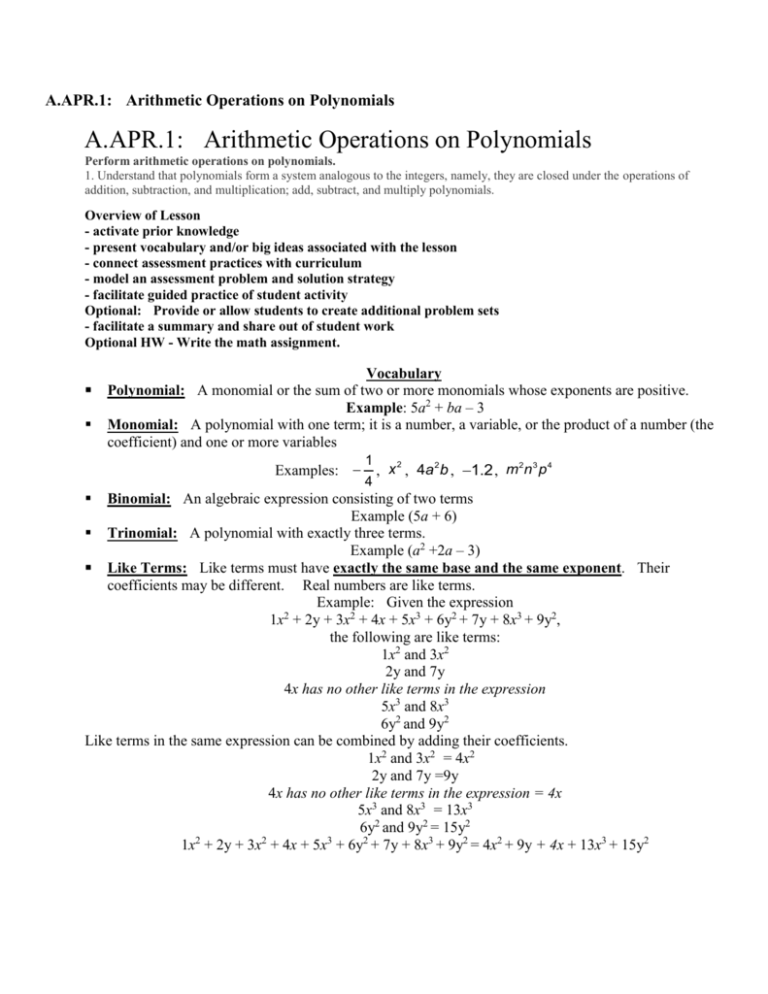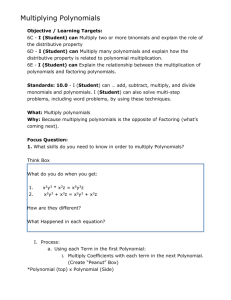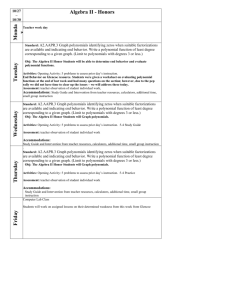DOC - JMap
advertisement

A.APR.1: Arithmetic Operations on Polynomials A.APR.1: Arithmetic Operations on Polynomials Perform arithmetic operations on polynomials. 1. Understand that polynomials form a system analogous to the integers, namely, they are closed under the operations of addition, subtraction, and multiplication; add, subtract, and multiply polynomials. Overview of Lesson - activate prior knowledge - present vocabulary and/or big ideas associated with the lesson - connect assessment practices with curriculum - model an assessment problem and solution strategy - facilitate guided practice of student activity Optional: Provide or allow students to create additional problem sets - facilitate a summary and share out of student work Optional HW - Write the math assignment. Vocabulary Polynomial: A monomial or the sum of two or more monomials whose exponents are positive. Example: 5a2 + ba – 3 Monomial: A polynomial with one term; it is a number, a variable, or the product of a number (the coefficient) and one or more variables Examples: 1 4 2 , x , 4a 2 b , 1.2 , m 2n 3 p 4 Binomial: An algebraic expression consisting of two terms Example (5a + 6) Trinomial: A polynomial with exactly three terms. Example (a2 +2a – 3) Like Terms: Like terms must have exactly the same base and the same exponent. Their coefficients may be different. Real numbers are like terms. Example: Given the expression 1x2 + 2y + 3x2 + 4x + 5x3 + 6y2 + 7y + 8x3 + 9y2, the following are like terms: 1x2 and 3x2 2y and 7y 4x has no other like terms in the expression 5x3 and 8x3 6y2 and 9y2 Like terms in the same expression can be combined by adding their coefficients. 1x2 and 3x2 = 4x2 2y and 7y =9y 4x has no other like terms in the expression = 4x 5x3 and 8x3 = 13x3 6y2 and 9y2 = 15y2 1x2 + 2y + 3x2 + 4x + 5x3 + 6y2 + 7y + 8x3 + 9y2 = 4x2 + 9y + 4x + 13x3 + 15y2 Adding and Subtracting Polynomials: To add or subtract polynomials, arrange the polynomials one above the other with like terms in the same columns. Then, add or subtract the coefficients of the like terms in each column and write a new expression. Addition Example Subtraction Example 4 3 4 3 Add: 3r 9r 8 4r 8r 8 Subtract: 3r 4 9r 3 8 4r 4 8r 3 8 3r 4 -9r 3 4r 4 +8r 3 -8 7r 4 -r 3 -16 3r 4 -8 - 4r 4 -9r3 - +8r -1r 4 3 -8 - -8 -17 r 3 +0 Multiplying Polynomials: To multiply two polynomials, multiply each term in the first polynomial by each term in the second polynomial, then combine like terms. Example: Multiply: -8r 2 9r 7 5r 1 STEP 1: Multiply the first term in the first polynomial by each term in the second polynomial, as follows: -8r 2 -5r+1 -8r 2 -5r +-8r 2 1 40r 3 -8r 2 STEP 2. Multiply the next term in the first polynomial by each term in the second polynomial, as follows: -9r -5r+1 -9r -5r +-9r 1 45r 2 -9r STEP 3. Multiply the next term in the first polynomial by each term in the second polynomial, as follows: 7 -5r+1 7 -5r +7 1 -35r+7 STEP 4. Combine like terms from each step. 40r 3 -8r 2 45r 2 -9r -35r +7 40r 3 +37r 2 -44r +7 REGENTS PROBLEMS 1. If and , then equals a. b. c. d. 2. A company produces x units of a product per month, where total revenue for the month. The functions are modeled by The profit is the difference between revenue and cost where the month? a. c. b. d. 3. Which trinomial is equivalent to a. b. 4. Subtract from represents the total cost and represents the and . . What is the total profit, , for ? c. d. . Express the result as a trinomial. 5. Fred is given a rectangular piece of paper. If the length of Fred's piece of paper is represented by width is represented by , then the paper has a total area represented by a. c. b. d. 6. Express the product of 7. If the difference and and the in standard form. is multiplied by , what is the result, written in standard form? A.APR.1: Arithmetic Operations on Polynomials Answer Section 1. ANS: B Strategy: To subtract, change the signs of the subtrahend and add. Given: Change the signs and add: PTS: 2 REF: 061403a1 NAT: A.APR.1 KEY: subtraction 2. ANS: B Strategy: Substitute and into . TOP: Addition and Subtraction of Polynomials Given: Therefore: PTS: 2 REF: 081406a1 NAT: A.APR.1 KEY: subtraction 3. ANS: D Strategy: Expand and simplify the expression TOP: Addition and Subtraction of Polynomials STEP 1 Expand the expression. STEP 2: Simplify the expanded expression by combining like terms. PTS: 2 REF: 081524ai NAT: A.APR.1 TOP: Operations with Polynomials KEY: mixed 4. ANS: Strategy: To subtract, change the signs of the subtrahend and add. Given: Change the signs and add: PTS: 2 REF: 011528a1 NAT: A.APR.1 TOP: Addition and Subtraction of Polynomials KEY: subtraction 5. ANS: B Strategy: Draw a picture and use the area formula for a rectange: . A=(2x-6)(3x-5) 3x-5 2x-6 PTS: 2 6. ANS: REF: 011510a1 NAT: A.APR.1 TOP: Multiplication of Polynomials Strategy: Use the distribution property to multiply polynomials, then simplify. STEP 1. Use the distributive property STEP 2. Simplify by combining like terms. PTS: 2 7. ANS: REF: 081428a1 NAT: A.APR.1 TOP: Multiplication of Polynomials Strategy. First, find the difference between multiply the difference by , the use the distributive property to . Simplify as necessary. STEP 1. Find the difference between the subtrahend and add. Given: Change the signs and add: STEP 2. Multiply by PTS: 2 REF: 061528AI KEY: multiplication . To subtract polynomials, change the signs of . NAT: A.APR.1 TOP: Operations with Polynomials








